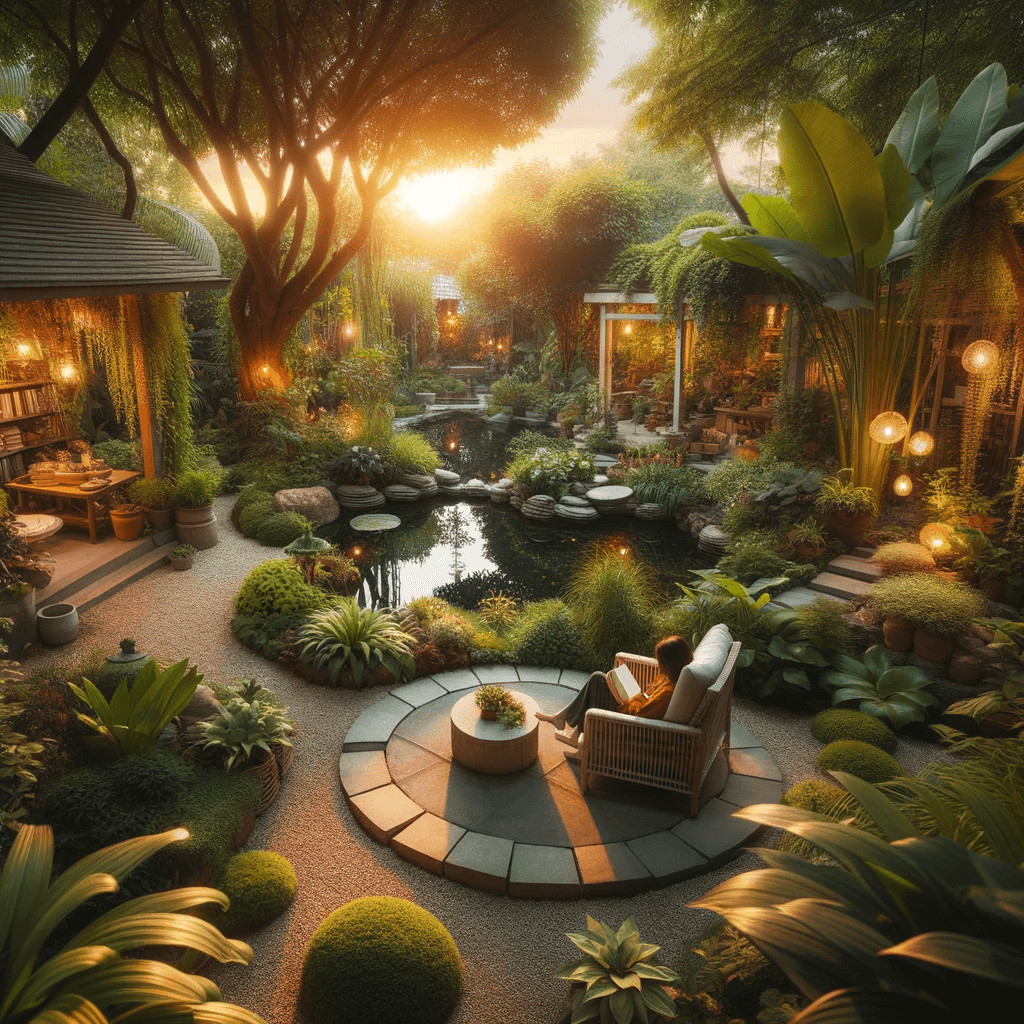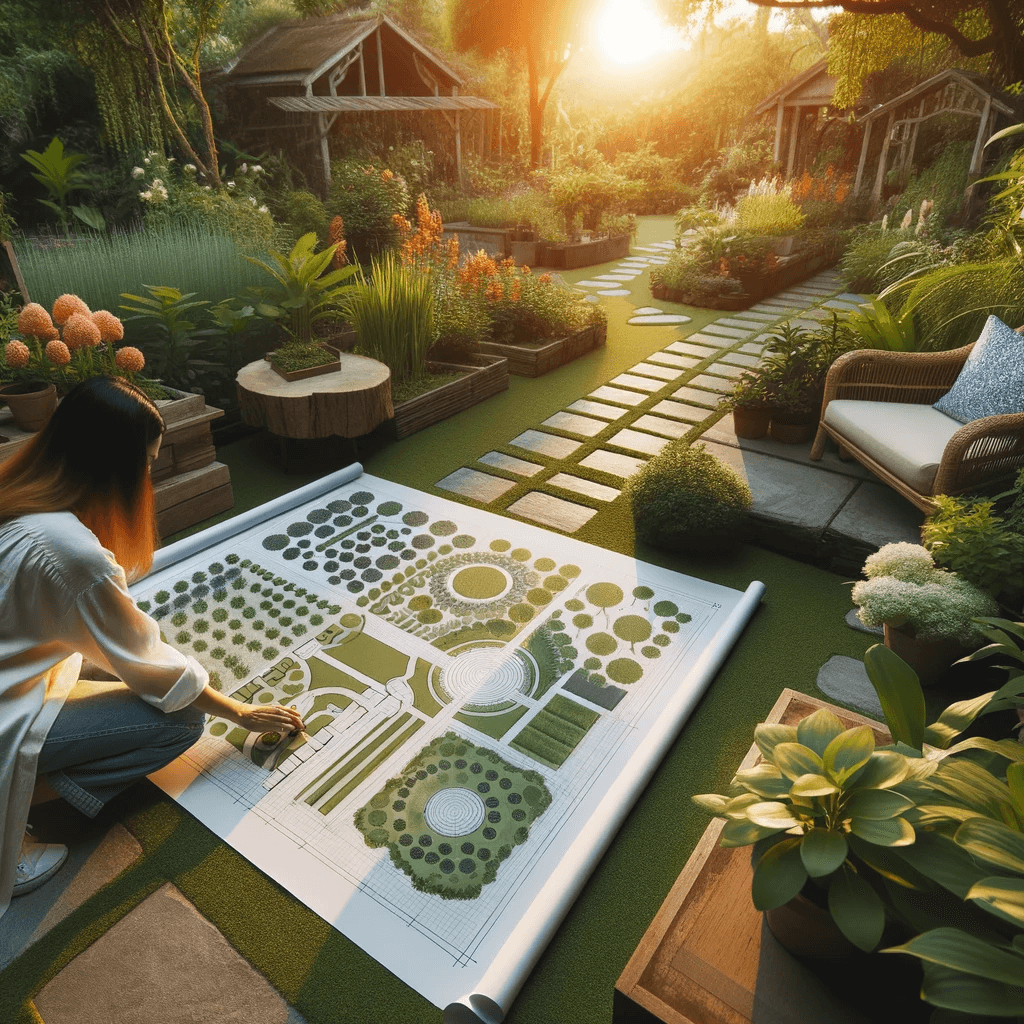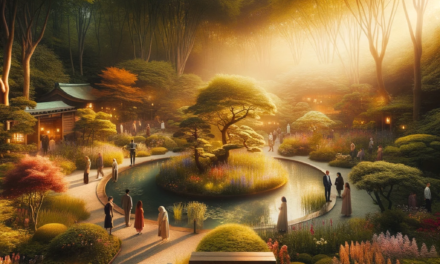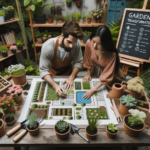Introduction
The art of gardening, while rooted in age-old traditions, has always been receptive to change. Each era has brought with it new techniques, philosophies, and tools, shaping the way we interact with our green sanctuaries. Now, as technology permeates every facet of our lives, it’s only natural that it finds its way into our gardens, offering a blend of the tactile joy of hands-on nurturing and the precision and convenience of modern tools.
Yet, as we usher in this new era of gardening, it’s essential to approach it with both enthusiasm and mindfulness. Technology, with its myriad offerings, promises to revolutionize our gardening experiences, making them more efficient, informed, and even eco-friendly. But it’s crucial to remember that at the heart of every garden lies the soul of the gardener—their dreams, memories, and hopes. No tool, however advanced, can replace this human touch.
Embarking on this exploration of contemporary gardening, we’ll delve into the harmonious melding of tradition and innovation. From the timeless act of planting a seed to harnessing cutting-edge tech tools for garden management, we invite you on a journey that promises to be both enlightening and heartwarming, celebrating the eternal bond between humanity and nature.
Table of Contents
Why Create a Garden Sanctuary?

Emotional and Mental Healing
In the embrace of a garden sanctuary, the world’s clamor gently fades, replaced by the soft whispers of leaves and the delicate songs of birds. Each step taken, each petal touched, offers a profound journey into emotional and mental healing. Let’s explore the transformative power of this sanctuary.
The Therapeutic Power of Nature
Nature, in its timeless wisdom, offers a balm for weary souls. The act of tending to a plant, watching it grow and thrive, mirrors our own journey of growth and resilience. As we nurture the earth, we’re subtly reminded of nature’s cycles of renewal and regeneration, offering hope and perspective in challenging times.
Reducing Stress and Anxiety Levels
The rhythmic patterns of gardening – the digging, planting, and watering – serve as grounding activities, anchoring us to the present moment. The vibrant colors of blossoms, the fragrance of herbs, and the soft rustle of foliage work in harmony to lower cortisol levels, the body’s primary stress hormone. In this haven, worries are momentarily set aside, replaced by a profound sense of peace and tranquility.
Offering a Retreat from Daily Pressures
In today’s fast-paced world, moments of solitude and reflection are treasures. A garden sanctuary becomes that cherished space where time slows, and the heart finds its rhythm. Whether it’s a quiet corner to read, a nook to meditate, or a pathway for mindful walks, a garden sanctuary offers a respite from the demands of daily life, inviting us to reconnect with our inner selves.
Sustainable Living and Eco-Wellness
In the heart of a garden, the interconnectedness of life unfolds, revealing the delicate balance of nature. Each plant, insect, and bird tells a story of coexistence and harmony. We also embrace a more profound commitment to sustainable living and eco-wellness as we nurture our gardens. Let’s journey into the green ethos of this sanctuary.
Supporting Biodiversity and Local Ecosystems
A thriving garden is a tapestry of life, woven with diverse threads of flora and fauna. By planting a variety of native species, we offer a haven for beneficial insects, birds, and other wildlife. These creatures, in turn, play vital roles in pollination, pest control, and soil health. Our gardens become micro-ecosystems, reflecting the beauty and complexity of nature in its entirety.
Contributing to a Healthier Environment
Every plant in our garden sanctuary is a silent warrior against environmental pollution. They act as natural air purifiers, absorbing carbon dioxide and releasing life-enriching oxygen. Moreover, gardens act as urban green lungs, combating the heat island effect and offering a cooling respite. Rain gardens and permeable pathways further aid in water conservation and reduce runoff, ensuring that every drop is cherished and utilized.
Promoting Sustainable and Organic Practices
By embracing organic gardening methods, we align with nature’s rhythms, avoiding synthetic fertilizers and pesticides that can harm the environment. Composting, mulching, and natural pest control methods not only nourish the soil but also ensure that our garden’s bounty is pure and untainted. These practices, rooted in respect for the earth, pave the way for a future where our garden and planet thrive side by side.
Enhancing Property Value and Aesthetics
Within the verdant embrace of a garden, there lies not just the charm of nature, but also a tangible reflection of care, creativity, and value. A thoughtfully designed garden sanctuary does more than please the eye; it enhances the very essence and worth of a property. Let’s delve into the ways a garden sanctuary elevates both aesthetics and value.
Boosting Curb Appeal and Property Worth
A well-tended garden is akin to a home’s welcoming smile, immediately capturing attention and admiration. Lush greenery, vibrant blooms, and manicured pathways make a lasting first impression, often influencing potential buyers’ perceptions. Studies have consistently shown that homes with beautiful gardens fetch higher market prices, making the investment in landscaping both a joy for the soul and a boon for the wallet.
Integrating Functional and Aesthetic Garden Elements
A garden’s beauty lies in its harmonious blend of form and function. Elements like pergolas draped in fragrant climbers, ornamental yet productive vegetable patches, or strategically placed water features not only serve a purpose but also elevate the garden’s visual appeal. Each element, whether it’s a bird bath that attracts avian visitors or a rose-covered trellis that offers shade, seamlessly marries utility with aesthetics.
Providing an Outdoor Extension of Living Space
In today’s world, outdoor living spaces have become coveted sanctuaries. A garden sanctuary, when designed with intention, extends the home’s living space. Patios adorned with comfortable seating, fire pits for cozy evening gatherings, or even outdoor kitchens become natural extensions of the indoor space. These areas, enveloped by nature, offer unique settings for relaxation, entertainment, and cherished moments with loved ones.
Planning Your Garden Sanctuary

In the heart of every dreamer blooms the vision of a garden sanctuary – a place where nature’s artistry and personal aspirations entwine in harmonious splendor. Crafting such a haven requires not just passion but also thoughtful planning. Guided by the whispers of leaves and the wisdom of seasons, let’s embark on the journey of shaping your dream sanctuary.
Understanding Your Space and Soil
Every piece of land, whether expansive or compact, tells a story. It’s crucial to listen to this story before embarking on your gardening journey. Begin by familiarizing yourself with the contours and dimensions of your garden space. This knowledge forms the blueprint upon which your sanctuary will emerge. As the day unfolds, observe the dance of shadows and sunlight across your plot. Different plants have distinct sunlight preferences, and understanding these patterns will guide your plant choices. Beyond the sun’s rays, delve beneath the surface. The soil, with its myriad textures and nutrients, is the lifeblood of your garden. Assess its type, be it sandy, loamy, or clayey, and consider a soil test. This will unveil its pH and nutrient levels, offering insights into which plants will thrive and what amendments might be needed.
Setting Clear Intentions
A garden, at its heart, is a manifestation of dreams and desires. It’s a space where the soul finds expression in the tangible world. Ponder upon what you seek from this sanctuary. Is it a tranquil retreat for meditation and reflection, or a vibrant canvas bursting with color and life? Perhaps it’s a space for family gatherings or solitary musings. The emotions you wish to evoke will shape the garden’s ambiance. Every plant, pathway, and water feature will play a role in this symphony of feelings. As you envision your garden, let your heart and soul guide the way.
Drafting a Design Blueprint
With clarity of intention, the next step is to translate your vision onto paper. Drafting a design is akin to painting a picture, where every stroke has purpose and meaning. Imagine the flow of your garden, the meandering pathways leading to hidden nooks, the open spaces bathed in sunlight, and the shaded corners offering respite on warm days. Think about the vistas you’d like to frame, be it a blossoming rose bush visible from your bedroom window or a serene pond reflecting the evening sky. Every element, from the tallest tree to the smallest pebble, has its place in this grand design.
Choosing Plants with Purpose
In the verdant world of plants, every leaf, petal, and root carries significance. As you select plants for your garden sanctuary, think of them as characters in a story. Native plants, adapted to the local climate, play the role of steadfast protagonists, resilient and vibrant. They often require less maintenance and provide habitats for local wildlife. Consider the symphony of seasons, choosing plants that offer visual interest throughout the year. Some might dazzle with spring blossoms, while others display fiery autumn hues or textured winter bark. Beyond aesthetics, think of functionality. Fragrant herbs, for instance, can be both culinary delights and sensory treats.
Incorporating Water Features

Water, with its ever-changing dance and gentle cadence, brings a unique magic to gardens. The mere presence of water – be it the gentle trickle of a fountain or the serene expanse of a pond – adds a layer of depth and dynamism to the garden’s ambiance. When incorporated thoughtfully, water features can transform a garden into a realm of reflection, tranquility, and wonder.
The allure of water features is multifaceted. On a sensory level, the sound of flowing water has a calming effect, soothing the mind and drowning out the noises of the outside world. It becomes a gentle soundtrack to the garden’s narrative, harmonizing with the rustle of leaves and the chirps of birds. Visually, water catches and plays with light, creating shimmering reflections and lending a touch of enchantment, especially during the golden hours of dawn and dusk.
Choosing the right water feature requires a blend of aesthetics and practicality. For smaller gardens, a compact fountain or a bubbling water urn can introduce the element of water without overwhelming the space. These features become focal points, drawing the eye and elevating the overall design. Larger gardens might accommodate ponds or even meandering streams.
These larger water bodies not only enhance the visual appeal but also support a diverse range of aquatic life. Water lilies, lotuses, and other aquatic plants add color and texture, while fish, like koi or goldfish, bring movement and life.
Yet, the beauty of water features is not without its responsibilities. Maintenance is crucial to ensure the water remains clear and the feature functions smoothly. Regular cleaning, ensuring water circulation, and monitoring for algae growth are essential tasks. For those keen on sustainability, rainwater harvesting can be integrated, providing an eco-friendly water source for the feature.
In essence, water features are more than mere decorative elements. They are the heartbeats of a garden sanctuary, resonating with the rhythms of nature and the emotions of those who wander amidst their beauty. By incorporating water into a garden sanctuary, one bridges the realms of land and water, crafting a sanctuary that sings with life, light, and endless wonder.
Adding Personal Touches

A garden sanctuary, in its purest essence, is a reflection of the soul that nurtures it. While nature paints with a broad brush of greens, blooms, and melodies, it is the personal touches that infuse a garden with distinct character and intimate warmth. These touches, subtle or bold, are the whispers of stories, memories, and dreams that weave through every leaf and stone, making the garden a living tapestry of one’s journey.
When you walk through a garden, every element can narrate a tale. Perhaps there’s a bench, weathered by time, where countless sunsets were witnessed, or a wind chime, carrying with it memories of a distant land. These personal touches are the anchors that root the garden in individual experiences, making it a sanctuary not just for the body, but for the heart and spirit as well.
Garden sanctuary furniture, for instance, is more than just functional pieces. They are the silent witnesses to shared laughter, contemplative moments, and the ever-evolving dance of life. Whether it’s a hammock that invites afternoon siestas or a mosaic table that sparks conversations, these pieces carry the imprints of moments lived and shared.
Decorative items, too, play a pivotal role in personalizing a garden. Sculptures, perhaps passed down through generations, become sentinels of history and heritage. Wind chimes and birdhouses introduce sound and life, each note and flutter resonating with personal meaning. Even stepping stones, hand-painted or inscribed, can chart the milestones of life’s journey.
Lighting, often overlooked, can dramatically alter the mood of a garden. A string of fairy lights can transform an evening into an ethereal wonderland, while lanterns and candles evoke a sense of nostalgia and romance. The play of light and shadow, when curated with personal intent, can create spaces of reflection, celebration, or solace.
Yet, beyond the tangible, it’s the intangible elements – memories, traditions, and rituals – that truly define a garden’s soul. Perhaps it’s the annual ritual of planting spring bulbs, the tradition of reading under a favorite tree, or the memory of a first flower bloom. These moments, though ephemeral, linger in the garden’s aura, making it a living testament to a life lived with passion and purpose.
Tech Tools for Garden Management

While the essence of gardening remains rooted in nature and tactile experiences, technological advancements offer tools that simplify, enhance, and revolutionize garden management. These innovations bridge the age-old art of gardening with the modern world’s conveniences, creating a harmonious blend of tradition and innovation.
The dawn of smart irrigation systems has been a game-changer for many gardeners. Gone are the days of manual watering or fretting about over or under-watering plants. These systems, often controlled via smartphone apps, allow for precise water distribution based on the garden’s needs. They take into account factors like soil moisture, weather forecasts, and plant type, ensuring that every droplet is optimally utilized. Not only do they conserve water, but they also promote healthier plant growth by providing consistent and appropriate moisture.
Garden monitoring apps serve as digital companions for gardeners, both novice and seasoned. These apps can track plant growth, offer reminders for tasks like pruning or fertilizing, and even provide insights into soil health. With augmented reality features, some apps even allow gardeners to visualize plant placements before making any physical changes, enabling better design decisions.
Smart planters and pots herald a new era of plant care. These aren’t just containers but intelligent systems that monitor conditions like soil moisture, ambient light, and even air quality. They can provide real-time feedback and, in some advanced versions, even self-water the plants based on the data they gather. For those who often travel or have busy schedules, these smart pots ensure that their green companions receive consistent care.
Additionally, the rise of garden drones offers a bird’s-eye view of larger gardens or orchards. These drones can help in monitoring plant health, checking for signs of pests or diseases, and even assisting in tasks like seeding. They provide a perspective that was previously challenging to achieve, allowing for better garden management.
Incorporating technology into gardening doesn’t diminish the joy of hands-on nurturing; instead, it amplifies the experience. It ensures that routine tasks are streamlined, leaving gardeners with more quality time to enjoy their sanctuaries, observe subtle changes, and engage in the therapeutic act of gardening. In essence, these tech tools are like silent garden assistants, working in the background to ensure that the garden thrives and the gardener’s journey is enriched.
Conclusion
Gardening, an age-old practice steeped in tradition, has beautifully evolved to embrace the conveniences of the modern world. The infusion of technology into this realm has not overshadowed the core essence of gardening but rather enhanced it, allowing us to interact with nature in ways previously unimagined. With tools that simplify tasks, offer insights, and provide innovative solutions, we find ourselves at a unique intersection of time-honored practices and cutting-edge advancements.
The harmony between hands-on nurturing and technological assistance paints a vibrant picture of contemporary gardening. It’s a dance where tradition and innovation move in tandem, each step elevating the other. This synergy ensures that while we remain deeply connected to the rhythms of the earth, we also harness the power of modern tools to make our gardening journey more enriching and efficient.
As we stand at this juncture, it’s essential to remember that technology, with all its marvels, is a tool—a means to an end. The heart of gardening remains unchanged: it’s about connection, growth, and the sheer joy of watching life unfold. Technology serves to enhance this experience, ensuring that our green sanctuaries flourish and that the timeless act of gardening adapts and thrives in our ever-evolving world.
In the grand tapestry of gardening, every thread—be it a seed sown with love or a smart irrigation system—holds significance. As we move forward, embracing both the wisdom of the past and the promises of the future, we continue the legacy of gardening, ensuring it remains a source of joy, solace, and inspiration for generations to come.
So go ahead, roll up your sleeves, and start creating your dream garden sanctuary. Your future self will thank you.







